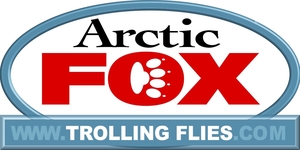When I took over the Jay Fair brand, among the tying materials were some old flies packaged with the insert “How To Fish J. Fairs Flies”. I re-typed the text and added a few more of the fly trolling principles Jay showed me when we fished together.
Photocopy of the original insert included with Jay’s flies in the 1990’s.
FAIR'S FLY FISHING and GUIDES SERVICE
You are being introduced to a new way of fishing. After fifty years of perfecting my method, these “Wooly Flashers”, fished properly, will out-fish any other method. Big fish love them. They are deadly in all types of water. The first thing you will notice is there will be no drag on your line like flashers etc.
Ninety percent of the food fish eat comes from the lake itself, like dragon flies, damsels, mayflies, shrimp, leeches, small minnows etc. We are representing this food in a very realistic way.
HOW TO FISH
1 Always fish in a circle or a zig-zag pattern.
2 Point your rods to the rear of the boat. In sharp turns a rod will not get tangled with this method. Both rods must be fished from the seat in front of the person running the motor, one on each side.
3 When line is out to the desired distance, move your rods back and forth 12 to 15 inches in a very smooth motion (not jerky). Keep your rod tips down to the level of the boat (gunnel). You will not miss strikes this way.
4 Wooly Flashers can be trolled slower than other methods.
5 Use one small split shot approximately 18 inches above the fly, when using monofilament. Troll 100 to 120 feet behind the boat. As the sun climbs higher in the sky and the fish go deeper add more shot for the desired depth.
6 Lead core line is a deadly way to fish, but very simple. As the water warms up, fish seek the temperature they are comfortable in. Each color of lead will put you down approximately 6 feet and normally three colors or 18 feet will be just about right. Some times if the weather is really hot you might have to fish as deep as 40 feet. Remember, the tighter the circle the deeper your line goes.
7 Fly colors will take some experimenting on your part. A good rule of thumb is; darker flies on darker days and lighter flies on lighter days.
8 Windy days are better than calm days.
As a licensed guide, I know you can learn this method in one day. Ask your dealer for details. A whole new world is going to be opened up for you and your family's fishing pleasure.
Keep a tight line and good luck. Jay Fair
Having fished with Jay I wanted to add a few more of his techniques not included in the original piece.
9 When practical do not fish into or out of the wind. Always troll across the wind or quartering on the wind. As the wind blows across a lake it pushed the top layer of water creating a current. There is a corresponding reverse current somewhere below the surface. The fish will tend to face into or out of the wind direction. They are more likely to chase a trolled fly if they see the profile of the fly rather than the nose-on or tail-on view.
10 An advantage to trolling Jay's “TOP LINE” ( 100' floating line/ half color lead core/ 25' of leader) when trolling in a zig-zag pattern is that the floating line will follow the track of the boat in “S” turns. When a fish strikes you will see the “S” turns begin to straighten well before you feel the tug on the rod. This is the signal to set the hook by pulling on the rod and/or accelerating the boat.
11 When you do get a hit it is more effective to “Pull Set” with the rod than lifting the rod to set the hook. To demonstrate the difference, hold the fly and have someone else do a hook set by lifting the rod. You will be surprised at how little power is transferred down the line due to the “give” in a limber rod. Then, with a taught line and the rod horizontal, pull the rod back from the fly. There is a dramatically increased amount of power at the business end of the line for setting hooks.
12 At Eagle Lake CA, Jay was trying to fish the edges of the tules and other structure that attracted feeding trout. The floating section of the “TOP LINE” will give you a much better idea of where your fly is behind the boat. Monofilament breaks through the surface close to the boat and it is more difficult to judge the location of the fly.
Denis Peirce
